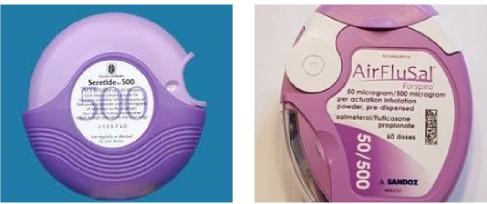High Court dismisses GSK’s claim that Sandoz’s AirFluSal Forspiro inhaler passes off GSK’s Seretide Accuhaler
Glaxo Wellcome v Sandoz & others
17.05.2020
Glaxo Wellcome (t/a Allen & Hanburys) v Sandoz & others[1]
In October 2019, Lord Justice Arnold gave judgment in a High Court claim between GSK and Sandoz relating to Sandoz’s AirFluSal Forspiro inhaler[2]. GSK alleged passing off, but its claims were dismissed in their entirety.
Background and marketing authorisation position
GSK sought to prevent the sale in the UK of the AirFluSal Forspiro, which is an inhaler for the treatment of COPD and asthma which contains the active ingredients combination of fluticasone and salmeterol. GSK alleged that the marketing of the AirFluSal Forspiro in its current colour, shape and packaging, amounted to passing off. Images of the two inhalers at issue are shown below.

GSK’s Seretide Accuhaler Sandoz’s AirFluSal Forspiro
Seretide, which is available in the Accuhaler form shown above, as well as in a ‘boot shaped’ metered dose inhaler, has been one of the most commercially successful pharmaceutical products since its launch in 1999. Following the expiry of GSK’s patents for the active ingredients combination within Seretide, the AirFluSal Forspiro and a number of other generics have been launched to compete with it.
Whilst Sandoz’s AirFluSal Forspiro inhaler contains the same active ingredients as Seretide, those ingredients are delivered by a proprietary dry powder inhaler device. The AirFluSal Forspiro’s marketing authorisation (“MA”) was therefore obtained under the route provided by Article 10(3) of the Medicinal Products Directive (2001/83/EC), which is sometimes termed the ‘hybrid’ route. This is the appropriate route for a product such as a dry powder inhaler which dispenses a locally acting product, the action of which in the body may depend upon the pattern of distribution of the active ingredient as delivered into the patient’s lungs. As a result of this route to market authorisation, the AirFluSal Forspiro’s MA varies in scope to that obtained by for the Seretide Accuhaler. This distinction formed an important pillar of GSK’s claims.
The alleged misrepresentations
GSK alleged the traditional form of passing off, i.e. a misrepresentation as to origin. However, as the trial approached, GSK’s focus shifted to a more unusual argument, namely that the colour and appearance of the AirFluSal Forspiro amounted to a false representation that the AirFluSal Forspiro is “equivalent” to the Seretide Accuhaler. In this regard, GSK relied on the following differences between the competing products in support of this alleged misrepresentation:
- The AirFluSal Forspiro has a narrower MA than the Seretide Accuhaler of an equivalent strength. In particular, the AirFluSal Forspiro was only licensed for COPD (not asthma) from its launch in November 2015 until February 2017 when the MA was varied. After that date, the MA was extended so as to also cover asthma, but only for adults with severe asthma.
- The Seretide Accuhaler is available in three strengths, whereas the AirFluSal Forspiro is only available (in the UK) in the highest of these strengths. This allows Seretide Accuhaler patients to be titrated down to a lower strength Accuhaler when their symptoms are under control. The same patient who is using an AirFluSal Forspiro would have to switch inhalers at this point, for example to the mid-strength Seretide Accuhaler.
- Patients require training when they first use the AirFluSal Forspiro, even if they have previously used a Seretide Accuhaler. That is because the two devices operate in very different ways.
The court’s findings
The court heard extensive evidence from a number of healthcare professionals, including prescribing doctors, asthma specialists and dispensing pharmacists, who gave evidence regarding the manner in which respiratory products were licensed by the MHRA, prescribed to patients, and then dispensed. In addition, the court looked at the development of asthma treatments over time, and historical trends including with regard to the use of colours on inhalers. The judgment also considered the shift in recent years away from generic prescribing of asthma inhalers (particularly for dry powder inhalers) and also the reimbursement of inhalers such as the Seretide Accuhaler, which is a Category C medicine on the NHS’s drugs Drug Tariff. All of this provided the context in which GSK’s passing off claims were assessed.
In relation to GSK’s origin confusion claim, the court found that there was no evidence that the purple colours used on GSK’s Seretide inhalers had become distinctive of either GSK or Seretide. It was therefore unsurprising that there was also no evidence that patients (or indeed anyone else) had been misled as to the commercial origin of the AirFluSal Forspiro as a result of its appearance. The origin confusion claim was therefore dismissed.
In relation to GSK’s equivalence claim, the court again found no evidence that the purple colour of Seretide was distinctive of the relevant characteristics of the Seretide Accuhaler, or that anyone was likely to be confused as to the characteristics of AirFluSal Forspiro due to its appearance, and in particular the use on that product of the colour purple. Instead, the healthcare professionals who gave evidence were all clear that they would not make any assumption about the marketing authorisations of inhalers based on their colour. The equivalence claim was therefore also dismissed.
What does the judgment mean for the wider industry
The judgment will be of particular interest to manufacturers of asthma and COPD inhalers, particularly generic inhalers and those authorised under the Article 10(3) ‘hybrid’ route. In particular, the Court looked in depth at the use of colours for asthma/COPD treatments, and in particular at how generic manufacturers have often used the same colour on their inhaler as the originator’s product. Think, for example, of the various blue inhalers containing salbutamol which come from a variety of suppliers and whose MAs can vary in scope. Whilst the judgment by no means provides certainty that adopting the same colour as an originator will be lawful, generic inhaler manufactures will be comforted by the fact that the court noted that that there is “a sound medical rationale behind this practice of generics adopting similar colour schemes to the originator products, as it promotes familiarity amongst patients with their inhalers…and hence patient adherence to their drug regime”.
As for originators who are looking to rely on ‘soft’ IP rights to protect their products following the expiry of the relevant patents, this case demonstrates the difficulties in succeeding on a claim in passing off. However, a claim based on a registered trade mark, or a registered design, may be a viable alternative with higher prospects of success. Originators will therefore no doubt continue to consider whether trade mark or design registrations could be obtained which might protect the ‘look and feel’ of their pharmaceutical products.
In the UK, GSK has sought permission to appeal the judgment, although this has been dismissed. GSK is also pursuing claims in other jurisdictions which relate to the same products.
————–
[1] Glaxo Wellcome v Sandoz & others [2019] EWHC 2845 (Ch)
[2] Bristows acted in these proceedings for two entities within the Vectura group. The Vectura parties were joined to the proceedings in June 2018 as co-defendants with Sandoz, having been responsible for the initial development of the inhaler device used in the AirFluSal Forspirow

Jeremy Blum
Author

Sean Ibbetson
Author
